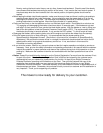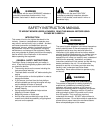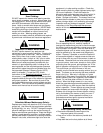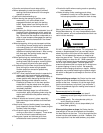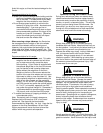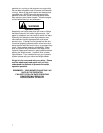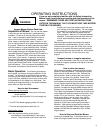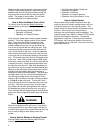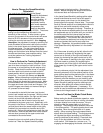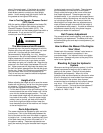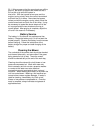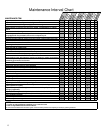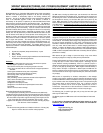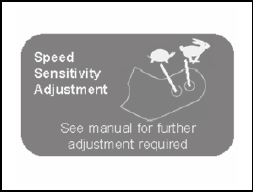
How to Change the Speed/Sensitivity
Adjustment
The controls are initially set with the Speed/
Sensitivity Adjustment
in the faster, more
sensitive position. If
an operator is not
completely familiar
with mower operation
the operator may
desire to decrease
10
the ground speed approximately 25-30%. The slower
setting has a corresponding decrease in the
sensitivity of the controls. In other words, a given
amount of movement of the control levers will cause
about a 25-30% decrease in the ground speed
making the controls less sensitive. After stopping
the engine, the adjustment is made by removing rod
ends connected to the control rods from the current
holes in the control levers and reinstalling them into
the alternate holes. The top holes closest to the
control handles are for the faster, more sensitive
setting and the bottom holes farthest from the control
handles are the slower, less sensitive setting. You
must then perform the Tracking Adjustment
described below.
How to Perform the Tracking Adjustment
First ensure that the tire pressure is equal on both
rear drive tires and equal on both front tires. Drive
the mower on a level parking lot with engine at full
throttle. Check that the mower drives in a straight
line when both hand controls are held to the full
speed position which is up against the stationary
control bar. If not, park the mower and stop the
engine. Before proceeding to adjusting the mower
tracking, check and make sure both controls move
freely through the forward and reverse range. Make
sure that debris has not hindered the movement of
the upper and lower control rods and linkages. If all
control linkages move freely and mower tracking is
off, proceed to the next step.
It is essential to start with the lower (and shorter)
control rods located near the pumps. With the control
levers in the neutral position, the right and left lower
control rod should be adjusted to allow their
respective torsion bar to remain level at the end
connected to the lower control rod. Specifically, with
the pump in the Return-To-Neutral position, the lower
rod end should be at the same height as the rigidly
fixed ball joint connected on the same end of the
torsion rod. Perform this adjustment on both the right
and left side. Now that the lower end of both torsion
rods are level, proceed to the upper control rods
connected to the control levers.
Loosen the jam nuts on both ends of the upper
control rod. Note: the Speed Sensitivity setting
should be set to the fast position. See previous
section. Before changing the length of the control
rods several facts are important to know.
In the faster Speed/Sensitivity setting neither cable
should be shortened so much that at full speed it
pulls the pump control lever (on the sides of the
pumps) against the pump’s internal stop. The pumps
have an internal stop that is not designed to take this
type of force and could eventually cause pump
leakage or other damage to the pump. Therefore, to
reach the maximum capable speed, the rods should
be lengthened one turn at a time until you can feel in
the hand control that the internal stop has been
contacted with the control handles in the maximum
forward position. Then shorten the cable one turn.
This will enable the stationary bar to stop the control
handle and protect the internal pump stop from
damage. Remember, this procedure does not apply
if the Speed/Sensitivity Adjustment is in the slower
setting.
So, if the mower is tracking to the left, either the left
side needs to go faster (by lengthening the upper
control rod on the left) or the right side needs to go
slower (by shortening the upper control rod on the
right). If the mower is tracking to the right, either the
right side needs to go faster (by lengthening the
upper control rod on the right) or the left side needs
to go slower (by shortening the upper control rod on
the left).
The only reference point to limit the adjustment from
becoming extremely off is the relative position of the
pump internal stop and the stationary bar in the faster
Speed/Sensitivity setting. Therefore, if everything is
extremely off either because you are installing new
parts or other reasons you should only use the faster
Speed/ Sensitivity setting to get the tracking to be
accurate. After getting the mower to track straight,
readjust the neutral adjustment , if necessary. It is
normal to need to make these adjustments from time
to time as the linkage breaks in or wears.
How to Test/Use the Blade Clutch/Brake
Switch
Before testing the blade clutch/brake operation, make
sure the area is clear and there is nothing vulnerable
to thrown objects from under the mower. No one
should be near the mower deck or in its line of
discharge. The discharge chute deflector should be
in the down position. The parking brake should now
be applied. Move the engine throttle to ¾ speed
setting. (When mowing, the engine speed should
always be at its highest setting. The engine governor
will regulate the engine according to the different
mowing conditions at that setting.) Place both feet
firmly on the foot platform and turn on the blade
clutch switch. Run blades for a minute or so. Try
engaging and disengaging the blades a few times



